TechUP Makersデモデイ - リハビリ支援のためのIoTデバイス『UbiCane』
0 likes1,444 views
一般社団法人ブロードバンド推進協議会が主催するTechUP Makersというプログラムに参加し,デモデイで発表したスライドです.
1 of 12
Download to read offline
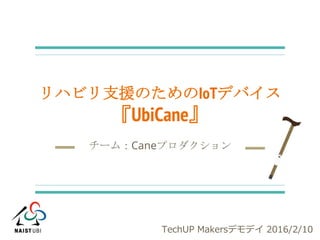
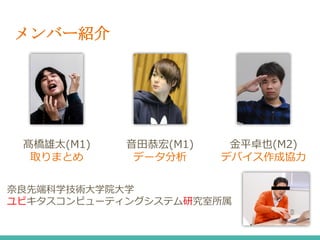
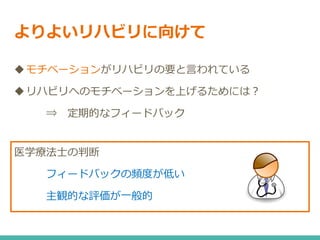
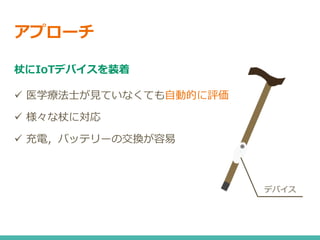
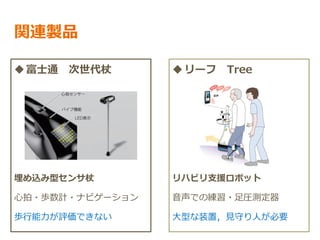
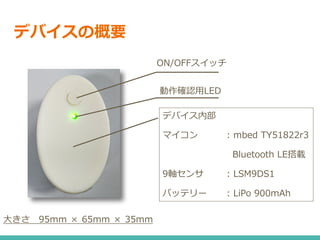
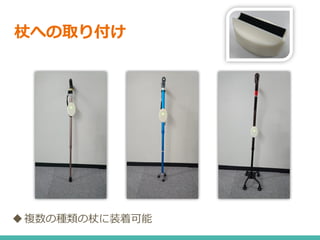

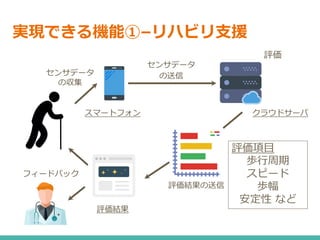

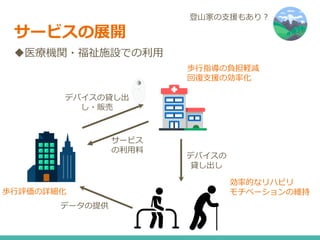
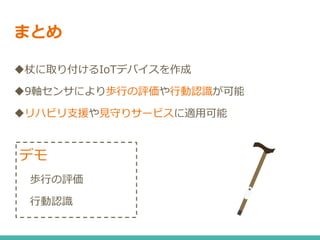
Ad
Recommended
労働生产性改善に向けたウェアラブル机器を用いた体调推定法の検讨
労働生产性改善に向けたウェアラブル机器を用いた体调推定法の検讨Yuta Takahashi
?
IPSJ SIG-MBL 第82回 WiPセッション
http://www.ishilab.net/mbl/program/2016/81.html
にて発表したスライドです.深层リカレントニューラルネットワークを用いた日本语述语项构造解析
深层リカレントニューラルネットワークを用いた日本语述语项构造解析Hiroki Ouchi
?
既存の日本語述語項構造解析では,形態素解析や構文解析を行い,それらの情報に基づいて各述語の項を予測していた.しかし,パイプライン処理に起因する誤り伝搬や,人手による素性設計コストの上昇などが問題点となっている.本研究では,深層リカレントニューラルネットワークを利用し,単語などの表層情報のみを用いて述語項構造解析を行う手法を提案する. また,複数の述語を同時に考慮して述語構造解析の精度を向上させるために,述語ごとのモデルをグリッド上に連結した深層リカレントグリッドモデルを提案する.NAIST テキストコーパスを用いた実験の結果,これまでに報告されている最先端の日本語述語項構造解析器の精度を上回ることを確認した.贬础厂颁と奥别办补を使って行动认识
贬础厂颁と奥别办补を使って行动认识Yuta Takahashi
?
2016/10/12(水)にIoTビジネスブーストアッププログラム「AIDOR」のIoTサービス編で使用したハンズオンスライドです
https://www.sansokan.jp/events/eve_detail.san?H_A_NO=21644交通事故データへの频出パターンマイニングの适用
交通事故データへの频出パターンマイニングの适用Yuta Takahashi
?
The document discusses the application of frequent pattern mining to analyze traffic accident data in Saga, Japan, emphasizing the need for a more efficient method of analysis compared to traditional statistical approaches. It outlines the methodologies used, including decision trees and clustering, and presents findings related to time rules, vehicle types, and correlations with age. Future work is suggested to validate the knowledge gained and potentially apply this method to real-world scenarios.位置?电力情报を基とした宅内行动认识システムへの居住者の加速度データの追加とその改善効果の调査
位置?电力情报を基とした宅内行动认识システムへの居住者の加速度データの追加とその改善効果の调査奈良先端大 情報科学研究科
?
The document outlines the work of a smart home team analyzing activity recognition using cell phone accelerometers, referencing relevant literature. It details various team members’ contributions, methodologies, and experimental results. Key outcomes are quantitative performance metrics indicating varying levels of accuracy across different approaches.#FTMA15 先端技術とメテ?ィア表現#2
#FTMA15 先端技術とメテ?ィア表現#2 Yoichi Ochiai
?
#FTMA15 先端技術とメディア表現#2
5月15日の講義の前半で用いた資料です.
後半は鬼コースと人間コースと仏コースのサーベイの発表がありました.#FTMA15 第七回課題 全コースサーベイ
#FTMA15 第七回課題 全コースサーベイYoichi Ochiai
?
#FTMA15 先端技術とメディア表現#8
6月26日の講義の後半で用いた資料です.
授業でやったサーベイの一枚まとめをシェアします.
仏人間コースはサーベイを、鬼コースは最終アウトプットとして論文を提出するため、実装と評価を含めた実際の研究をしています.
まとめてくれた@yopitaさんに感謝.魔法使いの研究室 Vol.1
魔法使いの研究室 Vol.1Yoichi Ochiai
?
5/1に行われたニコ生での公開授業のスライドです. ハッシュタグは #ochyainico
生放送の動画もあります.
http://live.nicovideo.jp/watch/lv218406272#FTMA15 先端技術とメテ?ィア表現3
#FTMA15 先端技術とメテ?ィア表現3Yoichi Ochiai
?
#FTMA15 先端技術とメディア表現#3
5月22日の講義の前半で用いた資料です.
後半は鬼コースと人間コースと仏コースのサーベイの発表がありました.落合陽一 筑波大 講演資料 10月17日
落合陽一 筑波大 講演資料 10月17日Yoichi Ochiai
?
落合陽一の筑波大での講演資料です.
10月17日に行われました.
まとめはこちら http://togetter.com/li/733516
http://96ochiai.wsDigital Nature Group at Ars Electronica Summit
Digital Nature Group at Ars Electronica SummitYoichi Ochiai
?
The document presents research from the Yoichi Ochiai Laboratory at the University of Tsukuba on their vision of "Digital Nature", which transforms audio-visual media from 2D pixels on flat screens to 3D "pixies" in haptic environments, the production of material existence, the shape of human presence, and human-computer relationships. The ecosystem of Digital Nature will involve interdisciplinary computational projects spanning multimedia systems, graphics, HCI research, fabrication, robotics, art, architecture, materials science, and biology. Examples of artwork and research achievements from their Digital Nature projects are exhibited.HMM, MEMM, CRF メモ
HMM, MEMM, CRF メモTakeshi Arabiki
?
This document discusses and compares several different probabilistic models for sequence labeling tasks, including Hidden Markov Models (HMMs), Maximum Entropy Markov Models (MEMMs), and Conditional Random Fields (CRFs).
It provides mathematical formulations of HMMs, describing how to calculate the most likely label sequence using the Viterbi algorithm. It then introduces MEMMs, which address some limitations of HMMs by incorporating arbitrary, overlapping features. CRFs are presented as an improvement over MEMMs that models the conditional probability of labels given observations, avoiding the label bias problem of MEMMs. The document concludes by describing how to train CRF models using generalized iterative scaling.PikaBreak: 光で休憩を促してくれるスマートタイマー
PikaBreak: 光で休憩を促してくれるスマートタイマーYuta Takahashi
?
株式会社サポーターズ:技育祭2020
ライトニングトーク大会「みんなに自慢したい無駄開発」
にて発表
- ソースコード
https://github.com/yuta-ubiquitous/PikaBreak
- デモ
https://www.youtube.com/watch?v=ciW0fZIznUQ生活リズムの类似性や周期性に基づく心身の健康状态の推定と予测
生活リズムの类似性や周期性に基づく心身の健康状态の推定と予测Yuta Takahashi
?
The document references various studies that investigate the relationship between stress and health outcomes, including mortality and academic performance. It discusses the use of health surveys and models for predicting stress levels and mental health. Key findings highlight the importance of perceptions regarding stress and their impact on overall well-being.観光中の内的状态推定に向けた観光客の无意识的しぐさの分析
観光中の内的状态推定に向けた観光客の无意识的しぐさの分析Yuta Takahashi
?
IEICE HPB第18回研究会@東京電機大で発表したスライドです.
http://ieicehpb.info/index.php?Kenkyukai18
セッション3 : 行動解析生产性の低下抑止のためのウェアラブル机器による体调の推定と予测
生产性の低下抑止のためのウェアラブル机器による体调の推定と予测Yuta Takahashi
?
The document discusses research on the impact of chronic health conditions on work performance and economic outcomes for employers. It also references studies on academic performance, mental health, and stress prediction using personality traits and machine learning. The insights aim to highlight the relationship between health and productivity in various contexts.DeepRemote: A Smart Remote Controller for Intuitive Control through Home Appl...
DeepRemote: A Smart Remote Controller for Intuitive Control through Home Appl...Yuta Takahashi
?
This document describes DeepRemote, a smart remote controller that uses deep learning for intuitive home appliance selection and control. It consists of a control unit with a camera and buttons and a deep learning unit for appliance recognition. The system was tested for classification accuracy of over 80% on average, response time of under 2 seconds, and faster control times than traditional remotes in user tests. Overall, DeepRemote demonstrates an effective deep learning approach for selecting and controlling home appliances intuitively with a single remote controller.An Identification Method of IR Signals to Collect Control Logs of Home Applia...
An Identification Method of IR Signals to Collect Control Logs of Home Applia...Yuta Takahashi
?
This document proposes a method to identify infrared (IR) signals from home appliances in order to collect control logs. It involves preprocessing raw IR signals into pulse width sequences, comparing signals using mean absolute error and sum absolute error, and constructing statistical models to identify appliance type with 95.5% accuracy and command type with 92% accuracy based on a database of 1,400 signals from 14 appliances. A simple simulation shows identification stability is achieved when the database includes 6 or more signals per appliance. The method could help automatically understand user preferences from appliance usage logs.More Related Content
Viewers also liked (15)
位置?电力情报を基とした宅内行动认识システムへの居住者の加速度データの追加とその改善効果の调査
位置?电力情报を基とした宅内行动认识システムへの居住者の加速度データの追加とその改善効果の调査奈良先端大 情報科学研究科
?
The document outlines the work of a smart home team analyzing activity recognition using cell phone accelerometers, referencing relevant literature. It details various team members’ contributions, methodologies, and experimental results. Key outcomes are quantitative performance metrics indicating varying levels of accuracy across different approaches.#FTMA15 先端技術とメテ?ィア表現#2
#FTMA15 先端技術とメテ?ィア表現#2 Yoichi Ochiai
?
#FTMA15 先端技術とメディア表現#2
5月15日の講義の前半で用いた資料です.
後半は鬼コースと人間コースと仏コースのサーベイの発表がありました.#FTMA15 第七回課題 全コースサーベイ
#FTMA15 第七回課題 全コースサーベイYoichi Ochiai
?
#FTMA15 先端技術とメディア表現#8
6月26日の講義の後半で用いた資料です.
授業でやったサーベイの一枚まとめをシェアします.
仏人間コースはサーベイを、鬼コースは最終アウトプットとして論文を提出するため、実装と評価を含めた実際の研究をしています.
まとめてくれた@yopitaさんに感謝.魔法使いの研究室 Vol.1
魔法使いの研究室 Vol.1Yoichi Ochiai
?
5/1に行われたニコ生での公開授業のスライドです. ハッシュタグは #ochyainico
生放送の動画もあります.
http://live.nicovideo.jp/watch/lv218406272#FTMA15 先端技術とメテ?ィア表現3
#FTMA15 先端技術とメテ?ィア表現3Yoichi Ochiai
?
#FTMA15 先端技術とメディア表現#3
5月22日の講義の前半で用いた資料です.
後半は鬼コースと人間コースと仏コースのサーベイの発表がありました.落合陽一 筑波大 講演資料 10月17日
落合陽一 筑波大 講演資料 10月17日Yoichi Ochiai
?
落合陽一の筑波大での講演資料です.
10月17日に行われました.
まとめはこちら http://togetter.com/li/733516
http://96ochiai.wsDigital Nature Group at Ars Electronica Summit
Digital Nature Group at Ars Electronica SummitYoichi Ochiai
?
The document presents research from the Yoichi Ochiai Laboratory at the University of Tsukuba on their vision of "Digital Nature", which transforms audio-visual media from 2D pixels on flat screens to 3D "pixies" in haptic environments, the production of material existence, the shape of human presence, and human-computer relationships. The ecosystem of Digital Nature will involve interdisciplinary computational projects spanning multimedia systems, graphics, HCI research, fabrication, robotics, art, architecture, materials science, and biology. Examples of artwork and research achievements from their Digital Nature projects are exhibited.HMM, MEMM, CRF メモ
HMM, MEMM, CRF メモTakeshi Arabiki
?
This document discusses and compares several different probabilistic models for sequence labeling tasks, including Hidden Markov Models (HMMs), Maximum Entropy Markov Models (MEMMs), and Conditional Random Fields (CRFs).
It provides mathematical formulations of HMMs, describing how to calculate the most likely label sequence using the Viterbi algorithm. It then introduces MEMMs, which address some limitations of HMMs by incorporating arbitrary, overlapping features. CRFs are presented as an improvement over MEMMs that models the conditional probability of labels given observations, avoiding the label bias problem of MEMMs. The document concludes by describing how to train CRF models using generalized iterative scaling.More from Yuta Takahashi (10)
PikaBreak: 光で休憩を促してくれるスマートタイマー
PikaBreak: 光で休憩を促してくれるスマートタイマーYuta Takahashi
?
株式会社サポーターズ:技育祭2020
ライトニングトーク大会「みんなに自慢したい無駄開発」
にて発表
- ソースコード
https://github.com/yuta-ubiquitous/PikaBreak
- デモ
https://www.youtube.com/watch?v=ciW0fZIznUQ生活リズムの类似性や周期性に基づく心身の健康状态の推定と予测
生活リズムの类似性や周期性に基づく心身の健康状态の推定と予测Yuta Takahashi
?
The document references various studies that investigate the relationship between stress and health outcomes, including mortality and academic performance. It discusses the use of health surveys and models for predicting stress levels and mental health. Key findings highlight the importance of perceptions regarding stress and their impact on overall well-being.観光中の内的状态推定に向けた観光客の无意识的しぐさの分析
観光中の内的状态推定に向けた観光客の无意识的しぐさの分析Yuta Takahashi
?
IEICE HPB第18回研究会@東京電機大で発表したスライドです.
http://ieicehpb.info/index.php?Kenkyukai18
セッション3 : 行動解析生产性の低下抑止のためのウェアラブル机器による体调の推定と予测
生产性の低下抑止のためのウェアラブル机器による体调の推定と予测Yuta Takahashi
?
The document discusses research on the impact of chronic health conditions on work performance and economic outcomes for employers. It also references studies on academic performance, mental health, and stress prediction using personality traits and machine learning. The insights aim to highlight the relationship between health and productivity in various contexts.DeepRemote: A Smart Remote Controller for Intuitive Control through Home Appl...
DeepRemote: A Smart Remote Controller for Intuitive Control through Home Appl...Yuta Takahashi
?
This document describes DeepRemote, a smart remote controller that uses deep learning for intuitive home appliance selection and control. It consists of a control unit with a camera and buttons and a deep learning unit for appliance recognition. The system was tested for classification accuracy of over 80% on average, response time of under 2 seconds, and faster control times than traditional remotes in user tests. Overall, DeepRemote demonstrates an effective deep learning approach for selecting and controlling home appliances intuitively with a single remote controller.An Identification Method of IR Signals to Collect Control Logs of Home Applia...
An Identification Method of IR Signals to Collect Control Logs of Home Applia...Yuta Takahashi
?
This document proposes a method to identify infrared (IR) signals from home appliances in order to collect control logs. It involves preprocessing raw IR signals into pulse width sequences, comparing signals using mean absolute error and sum absolute error, and constructing statistical models to identify appliance type with 95.5% accuracy and command type with 92% accuracy based on a database of 1,400 signals from 14 appliances. A simple simulation shows identification stability is achieved when the database includes 6 or more signals per appliance. The method could help automatically understand user preferences from appliance usage logs.超音波センサーを用いた4点杖の使用者のコンテキスト推定法の提案
超音波センサーを用いた4点杖の使用者のコンテキスト推定法の提案Yuta Takahashi
?
IPSJ UBISIG42で発表したパワポのスライドです.
English : Context Estimation for Quad Cane User by using Ultrasonic Sensor Ad
TechUP Makersデモデイ - リハビリ支援のためのIoTデバイス『UbiCane』
- 4. アプローチ 杖にIoTデバイスを装着 ü 医学療法?が?ていなくても?動的に評価 ü 様々な杖に対応 ü 充電,バッテリーの交換が容易 デバイス
- 5. 関連製品 u富?通 次世代杖 uリーフ Tree 埋め込み型センサ杖 ?拍?歩数計?ナビゲーション 歩?能?が評価できない リハビリ?援ロボット ?声での練習??圧測定器 ?型な装置,?守り?が必要
- 6. デバイスの概要 ?きさ 95mm × 65mm × 35mm ON/OFFスイッチ 動作確認?LED デバイス内部 マイコン : mbed TY51822r3 Bluetooth LE搭載 9軸センサ : LSM9DS1 バッテリー : LiPo 900mAh
- 10. 実現できる機能②–?守りサービス スマートフォン クラウドサーバ センサデータ の送信センサデータ の収集 ? 杖の利?頻度 ? ??の?動記録 ? 歩?能?の測定 ? 杖を正しく使?で きているか? レポート
